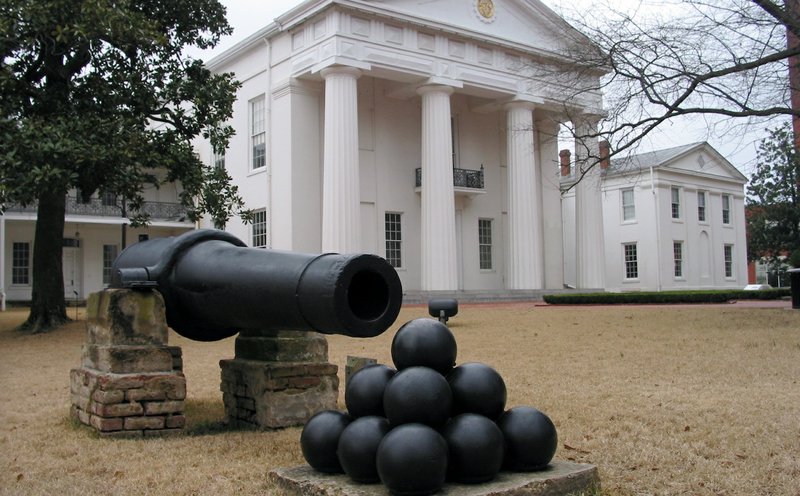The Lady Baxter cannon stands impotent guard over a pile of fused iron balls and its own confusing backstory on the front lawn of the Old State House in downtown Little Rock.
A relic of the Brooks-Baxter War of April and May 1874, the big gun arrived in Arkansas in 1862 aboard the CSS Pontchartrain. The Pontchartrain was a Confederate warboat deployed from New Orleans to block Union shipping on the White and Arkansas rivers. According to articles in the Encyclopedia of Arkansas History and Culture, in summer 1863 it was at Little Rock to menace Union Gen. Frederick Steele's army, which was marching west across the state.
According to an eyewitness account that historian Tom Dillard quoted in his column in the Arkansas Democrat-Gazette on Feb. 11, 2018, the cannon first was taken off the ship and set up on Hangar Hill to overlook the river; but as Steele approached it was hauled to the north shore.
According to an essay by Kenneth C. Barnes in Sentinels of History (University of Arkansas Press, 2000), when Steele took the city Sept. 10, 1863, Confederate soldiers fled. Before they went they succeeded in burning the Pontchartrain, which was stuck in the mud, but failed to burst the cannon.
Disabled, its 10-foot iron bulk lay half-buried in sand on the riverbank for a decade. Then partisans loyal to Gov. Elisha Baxter resurrected it during a tragicomic month of turmoil within the state Republican Party that caused an estimated 200 casualties: the Brooks-Baxter War. Most of the casualties happened in armed conflicts at Palarm and Pine Bluff, but there was violence on the streets of Little Rock.
In the final years of Reconstruction, state Republicans splintered into factions that by 1874 were nicknamed Brindletails and Minstrels.
The Brindletails were so named after their leader James Brooks, who was said to have a voice like a brindle bull. According to the Encyclopedia of Arkansas, the Minstrels took their name from the past occupation of a prominent member.
Brindle means brownish and streaky colored. What does a brindle bull sound like? Observe several possibilities right here.
Both factions sought support from former Confederate soldiers by promising to restore their voting rights, and both had supporters among freedmen. But the Minstrels were the power structure created by heavy-handed Reconstruction Gov. Powell Clayton. Personal interests and festering feelings blew up, as it were, in 1872 when the Powell machine's candidate, Baxter, was declared the winner over the Brindletail Brooks in an election that Harry S. Ashmore's Arkansas: A History notes featured widespread fraud on both sides.
For a taste of the complicated personal histories that collided, read historian Michael Dougan's Encyclopedia of Arkansas article on Baxter.
Conflicts broke out in and around the State House, where Baxter's men set up that cannon and two Parrott guns. Barnes writes, "The four weeks that followed were tense times as bugles blasted, troops drilled, and men jeered at each other in downtown Little Rock. Occasionally, trigger-happy soldiers let loose. Nearly all the casualties resulted from indiscriminate shooting and the chaos that ensued."
A maid fell out of a hotel window, for instance. Adding to a carnival-like atmosphere, a brass band from Pine Bluff entertained the Brindletails, and a black band played at the State House for Brooks' men.
The cannon was fired only once in 1874 — to celebrate Baxter's victory in a re-election ordered by President Ulysses S. Grant. The arm of the man who fired it was badly injured, making him the war's final casualty.
The Brooks-Baxter War effectively marked the end of Reconstruction in Arkansas, the decline of the Republican Party and the rise of the conservative white Democrats who dominated state politics through the first half of the 20th century.
This writer is unfit intellectually to sum up the conflict in any more depth than this, and only in part because it was not a clash of distinct ideologies: It's tricky to keep Brooks and Baxter aligned in the mind with the interests they represented. I can offer this mnemonic: "Brooks" begins with "Br" and so does "Brindletail."
Beyond that, the reader must seek the counsel of qualified historians and then look to his own wits for help.
Style on 04/01/2019
